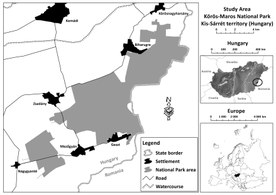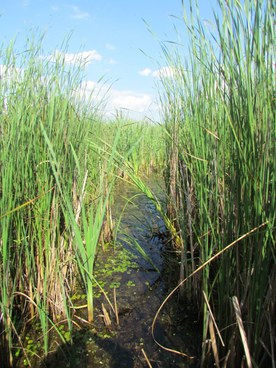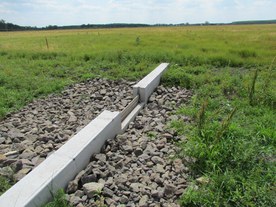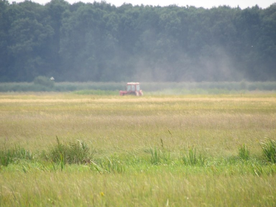Climate adapted management of the Kis-Sárrét area in the Körös-Maros National Park

In Hungary's Kis-Sárrét area, a Climate-Adapted Management Plan (CAMP) developed in 2013 addresses climate-related risks affecting the habitats and biodiversity loss in the Körös-Maros National Park. Measures include maintaining water regimes, preventing invasive species, and preserving river habitats.
The Kis-Sárrét area is located in south-eastern Hungary close to the Romanian border. The area is part of the Körös-Maros National Park and is included in the Natura 2000 network. It hosts numerous plants, animals, and habitat types of EU community importance. Its landscape has undergone dramatic changes during the past 200 years. In particular, extensive marshes were reduced and altered as a result of water regulations between 1856 and 1879. As a consequence, many areas constantly or temporarily covered by water disappeared, and the traditional management of the natural landscape changed. Notwithstanding, some parts of the area are still seasonally covered by water, due to slightly higher elevation and ensure appropriate conditions for alkaline habitats. These habitats are used for livestock grazing (Hungarian grey cattle, racka sheep, and water buffalo) and hay mowing. The grazing season traditionally lasts 191 days, from 24 April until late October.
Trends of decreasing summer precipitation and increasing temperature during the summer months were registered in the area during the past decades, causing a high climatic water balance deficit during June, July and August, i.e. the most critical months for grazing. In some years this hot and dry spell resulted in low summer precipitation that failed to compensate for the accumulated evapotranspiration, creating a cumulative water balance deficit of up to 200 mm.
To address these impacts, a specific climate-change adaptation management plan (which includes management strategies and measures, restrictions, barriers, indicators, and methods for stakeholder engagement) was developed in 2013. The Climate-Adapted Management Plan (CAMP) has not been updated since then. However, several measures were implemented through the CAMP and in following years in order to manage the water regime of wetlands.
Case Study Description
Challenges
Climate observations, derived from the E-OBS dataset, (i.e. the gridded version of the ECA dataset on climate variable) revealed that a general trend in increasing temperature has been observed in Europe between 1960 and 2018, not only in the Mediterranean area but also in central and north-eastern Europe. In the same period, Hungary experienced a significant warming (+ 0.3-0.35 °C per decade), and a major frequency in heatwaves (+6-8 days per decade) (see the EEA indicators on temperature). Precipitation is highly variable during seasons and years, with heavy precipitation events occurring especially in winter. Future projections indicate that these extreme events will increase in the next decades (up to 35%). Drought frequency has increased since 1950, up to +1.3 events per decade (see the EEA indicators on meteorological and hydrological droughts). Climate projections, based on EURO-CORDEX data, indicate an increase in average annual temperature between 2-4 °C, by the end of the 21st century, according to RCP4.5 and RCP8.5 scenarios, respectively (see the EEA indicators on temperature), and a slight increase in drought frequency in the period 2041-2070 in the two emission scenarios (see the EEA indicators on meteorological and hydrological droughts).
These changes are expected to have diverse impacts on the habitats and biodiversity of the Körös-Maros National Park, the extent and timing of which will depend on individual sensitivities to climatic changes, as described below.
Pannonic salt steppes and salt marshes
These habitats are very dependent on the duration of wetting and temperatures, both of which affect salt accumulation and other soil characteristics. Periods of low or no rainfall result in drying of the steppes and marshes (note that there is already a regular trend of drying), while excess summer rainfall may increase leaching of the soil, leading to reducing salt characteristics and thereby salt steppes and marshes degradation. Sodic habitats are among the most endangered as they provide special, complex soil conditions that can support both steppic meadow species (due to humus content), meadow species (due to groundwater effects) and sodic species (due to sodium-salt accumulation at around 1 m depth). If any of these processes/conditions change (becomes stronger or weaker), the habitat composition will change. Variable circumstances and climate extremes, including those as a result of projected climate change, can be beneficial for habitats such as dense and tall Puccinellia swards or Annual salt pioneer swards of steppes and lakes.
Natural eutrophic lakes with Magnopotamion or Hydrocharition - type vegetation
As a projected impact of climate change, decreasing rainfall harms hydrophyte vegetation since the reduced level of water can affect species development and survival, thus simplifying species composition and reducing biodiversity. Species number may fall as species with tight ecological tolerance disappear. Species requiring high naturalness state of habitat (Myriophyllum verticillatum, Ceratophyllum demersum, C. submersum, Utricularia australis, Salvinia natans) will be at risk of disappearing. The increase of less sensitive species is expected.
Pannonic loess steppic grasslands
As species composition of these habitats is dependent on annual rainfall, this may be affected with projected changes in climate. Decreasing water from wet areas during summer threatens species composition as a result of lowering groundwater table.
Alluvial meadows of river valleys of the Cnidion dubii
As a consequence of lowering groundwater table, these meadows are at risk of drying out and, in parallel, becoming weedier. Several of their stands rely on a shorter spring inundation.
Alluvial forests with Alnus glutinosa and Fraxinus excelsior
These habitats are extremely endangered as the water scarcity, due to projected climate change, might impede the renewal /regeneration of tree and shrub species.
Objectives
To address the main climate-related risks affecting the habitats and biodiversity of the Körös-Maros National Park, where the Kis-Sárrét area is located, a Climate-Adapted Management Plan (CAMP) was elaborated with the involvement of experts and local stakeholders. Main objectives of the CAMP are:
- Improvement of the resilience of protected and valuable habitats in the CAMP area;
- Intensification and improvement of stakeholder dialogues within the park;
- Deepening studies to deal with uncertainties in climate-change projections;
- Integration of climate change scenarios in the management of habitats;
- Improvement and specification of monitoring activities;
- Implementation of an “active adaptive management” approach for the CAMP area;
- Development of exemplary management plans for Natura 2000 Habitats that integrate the latest knowledge about climate change and its impacts;
- Integration of the results of climate modelling and hydrological modelling in the management of protected habitats.
Adaptation Options Implemented In This Case
Solutions
Since 2013, several measures were implemented in line with the CAMP to deal with the consequences of climate change:
- Maintenance of water regime, solving the problem of water supply and water excess due to neglected waterworks, avoiding too high water level during spring (not to threaten nesting birds and private-owned areas) or summer (enabling mowing and cutback of Typha stands) by directing water into canals towards fishponds
- Prevention against invasive species. This includes shredding, cutting or harvesting exotic species, banning burning, introducing sheep and /or cattle grazing in some areas (includes selection of proper cattle breeds and times of grazing for optimizing the benefits), avoiding overgrazing in wet areas, mowing, prohibiting the introduction of exotic fish species into the waters
- Preservation and restoration of river habitats and their connectivity with adjoining terrestrial habitats (lateral connectivity)
More recently (2019), in addition to CAMP measures, the National Park directorate (NP) implemented several small interventions in the Kis Sárrét area of the Körös-Maros National Park to retain water in the wetlands, as part of the Natura 2000 management plan, adopted in 2018. Although these measures are officially not labelled as climate adaptation measures (but as habitat conservation, management and reconstruction project), they definitely help the natural areas to cope with water scarcity, drought, and flooding as well and adapt to climate extremes. Implemented measures include:
- Demolition of some dykes in order to retain water in the wetlands
- Re-naturalization of some canals (or conservation of some canal making them to be less deep) in order to restore river habitats and their connectivity with terrestrial habitats
- Building of a new canal in order to lead water to a valuable wetland from a greater existing canal
- Reconstruction of sluice gates enabling the park rangers to control the level of inundation and inland water level in the marshes.
Relevance
Case mainly developed and implemented because of other policy objectives, but with significant consideration of Climate Change Adaptation aspects
Additional Details
Stakeholder Participation
Key stakeholders for the CAMP elaboration and implementation were nature conservation administrations acting at the local, regional and national levels, water management administrations on regional level, regional tourism associations and research institutions. The National Park administration along with national nature conservation and water management authorities were part of the key stakeholders, too. Media communication, such as press releases and newspaper articles were produced to increase awareness on climate change and to bring to the attention of the public the need for identifying measures to manage the Park under climate change conditions.
Currently, local stakeholders are not directly involved in the decision about the adaptive management of the Körös-Maros National Park. However, the park promotes awareness raising initiatives, for example through environmental education programmes for children and fair and exhibition events involving the local and regional stakeholders.
Success and Limiting Factors
One of the main success factors in the implementation of the adaptation measures was the profound knowledge of national park officers and park rangers, and their direct connection to the land owners and users (farmers). On the other hand, the measures implemented to retain water regime affect directly mainly state-owned areas that are managed by the NP. In fact, the farmers who rent the land from the state have to strictly follow specific nature conservation restrictions imposed by the NP (e.g. late mowing, no night works, no irrigation of grasslands, leave unmoved stripes, etc.), but they are compensated for these limitations with a low renting fee).
Costs and Benefits
Cost for the whole basic study and CAMP planning process was about 50,000 EUR; funding sources were 85% EU ERDF and 15% national. Data on costs for the implementation of measures are not publicly available.
Benefits include: maintenance of the water regime (which helped addressing the problem of water supply and excess), increase in the resilience of agricultural systems, maintenance or recovery of several protected habitats and endangered species, and strengthening local stakeholders’ consciousness and willingness to decrease carbon footprint as well as to adapt to climate change. Benefits are hard to quantify. However, according to the Department of Nature Conservation and Landscape Management (Szent István University, Gödöllő, Hungary), marshes look better than in the previous decades, and are probably more similar to their original appearance 200 years ago. Also weed infestation and penetration of invasive species was prevented thanks to the implementation of the measure aiming to ensure sufficient water quantity.
Legal Aspects
Recommendations for the management of climate-induced changes for regional partners were developed in the form of a best practice report and management strategy guidelines. From the lessons learned, policy recommendations were produced which can be useful to inform national and European law with a special focus on the Water Framework Directive and the Natura 2000 framework (Habitats-Directive, Birds Directive).
Implementation Time
The CAMP plan was developed between March 2010 and February 2013. CAMP measures were implemented between 2013 and 2019. Last measures promoted by the National Park Directorate were implemented in 2019.
Life Time
Adaptive management of the natural habitats of the Körös-Maros National Park is a continuous activity, requiring monitoring, evaluation and adjustment. New measures are implemented when needed and according to the available funds.
Reference Information
Contact
Ákos Malatinszky
Szent István University
Department of Nature Conservation and Landscape Management
Pater K. 1., 2103 Gödöllő, Hungary
E-mail: malatinszky.akos@szie.hu
Websites
Reference
Department of Nature Conservation and Landscape Management of Szent István University and Climate Change Adapted Management Plan (CAMP) for Körös-Maros NP areas
Published in Climate-ADAPT Jun 07 2016 - Last Modified in Climate-ADAPT Apr 04 2024
Please contact us for any other enquiry on this Case Study or to share a new Case Study (email climate.adapt@eea.europa.eu)





